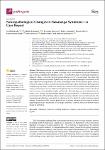| dc.contributor.author | Hotterbeekx, An | |
| dc.contributor.author | Lammens, Martin | |
| dc.contributor.author | Onzivua, Sylvester | |
| dc.contributor.author | Lukande, Robert | |
| dc.contributor.author | Olwa, Francis | |
| dc.contributor.author | Kumar-Singh, Samir | |
| dc.contributor.author | Van Hees, Stijn | |
| dc.contributor.author | Idro, Richard | |
| dc.contributor.author | Colebunders, Robert | |
| dc.date.accessioned | 2023-06-26T12:42:58Z | |
| dc.date.available | 2023-06-26T12:42:58Z | |
| dc.date.issued | 2021 | |
| dc.identifier.citation | Hotterbeekx, A.; Lammens, M.; Onzivua, S.; Lukande, R.; Olwa, F.; Kumar-Singh, S.; Van Hees, S.; Idro, R.; Colebunders, R. Neuropathological Changes in Nakalanga Syndrome—A Case Report. Pathogens 2021, 10, 116. https://doi.org/10.3390/pathogens 10020116 | en_US |
| dc.identifier.uri | https://doi.org/10.3390/pathogens 10020116 | |
| dc.identifier.uri | http://ir.lirauni.ac.ug/xmlui/handle/123456789/715 | |
| dc.description.abstract | Nakalanga syndrome is a clinical manifestation of onchocerciasis-associated epilepsy characterized
by stunting, delayed or absent secondary sexual development and skeletal deformities,
and is often accompanied by epileptic seizures. The pathophysiology of Nakalanga syndrome is
unknown. Here, we describe the post-mortem findings of a 17-year-old female who died with
Nakalanga syndrome in northern Uganda. Macroscopic and histopathological examination of all
major organs (liver, lungs, kidney and heart), including the brain and the pituitary gland, was performed.
The suspected cause of death was malaria, and all major organs and pituitary gland appeared
normal, except the lungs, which were edematous consistent with the malaria. Neuropathological
changes include signs of neuro-inflammation (gliosis and activated microglia), which co-localized
with tau-reactive neurofibrillary tangles and threads. The pathology was most abundant in the
frontal cortex, thalamic and hypothalamic regions, and mesencephalon. The choroid plexus showed
psammoma bodies. These findings indicate accelerated aging, probably due to repeated seizures. The
neuropathological findings were similar to other persons who died with onchocerciasis-associated
epilepsy. Examination of the pituitary gland did not reveal new information concerning the underlying
pathophysiological mechanism of Nakalanga syndrome. Therefore, more post-mortem studies
should be performed. | en_US |
| dc.language.iso | en | en_US |
| dc.publisher | Pathogens | en_US |
| dc.subject | kalanga syndrome | en_US |
| dc.subject | nodding syndrome | en_US |
| dc.subject | epilepsy | en_US |
| dc.subject | post-mortem | en_US |
| dc.subject | pituitary gland | en_US |
| dc.subject | Uganda | en_US |
| dc.title | Neuropathological Changes in Nakalanga Syndrome—A Case Report | en_US |
| dc.type | Article | en_US |

